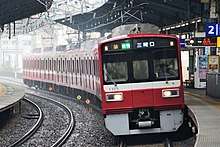Keikyu 1500 series
The Keikyu 1500 series (京急1500形) is an electric multiple unit (EMU) train type operated by private railway operator Keikyu on commuter services in the Tokyo area of Japan since 1985.[1]
| Keikyu 1500 series | |
|---|---|
| Manufacturer | Tokyu Car Corporation, Kawasaki Heavy Industries |
| Constructed | 1985–1991 |
| Entered service | 1985 |
| Refurbished | 2002– |
| Number built | 166 vehicles (28 sets) |
| Number in service | 158 vehicles (27 sets) |
| Formation | 4/6/8 cars per trainset |
| Operator(s) | Keikyu |
| Specifications | |
| Car body construction | Aluminium, steel (sets 1501 to 1517)) |
| Car length | 18,000 mm (59 ft 1 in) |
| Width | 2,830 mm (9 ft 3 in) |
| Doors | 3 pairs per side |
| Maximum speed | 120 km/h (75 mph)[1] |
| Traction system | Field chopper Variable frequency (GTO/IGBT) |
| Electric system(s) | 1,500 V DC |
| Current collection method | Overhead catenary |
| Multiple working | 600 series, N1000 series, 2000 series, 2100 series |
| Track gauge | 1,435 mm (4 ft 8 1⁄2 in) |
Operations
The eight-car sets are primarily used on limited-stop "Rapid Limited Express" and "Limited Express" services on the Keikyu Main Line, including through-running services to and from the Toei Asakusa Line and the Keisei Oshiage Line.[1] The four- and six-car sets are mostly used on all-stations "Local" services.[1] The 1500 series sets can be used in multiple with other Keikyu EMU types, including the 600 series, N1000 series, 2000 series, and 2100 series.[1]
Formations

As of 1 April 2017, the fleet consists of 158 vehicles formed as four-car, six-car, and eight-car sets, as follows.[2]
4-car sets 1501 to 1525
| Designation | M1c | M2 | M1 | M2c |
|---|---|---|---|---|
| Numbering | 15xx | 15xx | 15xx | 15xx |
6-car sets 1529 to 1593
15 x six-car sets formed by adding two 1900 trailer cars to four-car sets.
| Designation | M1c | M2 | Tu | Ts | M1 | M2c |
|---|---|---|---|---|---|---|
| Numbering | 1xxx | 1xxx | 19xx | 19xx | 1xxx | 1xxx |
- The "M1c" cars are fitted with one lozenge-type pantograph, and the "M1" cars are fitted with two.[2]
8-car sets 1701 to 1731
Five x eight-car sets formed by adding two 1900 trailer cars to six-car sets.
| Designation | M1c | M2 | Tu | Ts | M1 | M2 | M1 | M2c |
|---|---|---|---|---|---|---|---|---|
| Numbering | 17xx | 17xx | 19xx | 19xx | 17xx | 17xx | 17xx | 17xx |
- The "M1c" and end "M1" cars are each fitted with one lozenge-type pantograph, and the centre "M1" cars are fitted with two.[2]
Interior
Passenger accommodation consists of longitudinal bench seating throughout.[1]
History
The 1500 series fleet was built between 1985 and 1991.[1] The first five four-car sets delivered had steel bodies, while all subsequent sets had aluminium bodies with door pocket windows discontinued.[1] Sets built from 1990 onward used VVVF control.[1]
A programme of life-extension refurbishment commenced in 2002. This involved adding new air-conditioning units, removing the original door pocket windows of the steel bodied cars, and adding front-end skirts.[1]
On September 24th, 2012, set 1701 derailed between Oppama Station and Keikyu Taura Station. It was since retired and was replaced by Keikyu N1000 set 1169.
Livery variations
From 25 February 2018, four-car set 1521 was finished in a special "Keikyu 120 years of progress" livery with each of the four cars carrying a different livery used by Keikyu trains in the past. The livery remained on the car until 24th February 2019.[3] Car 1 carries the dark red used on 51 series EMUs from 1924 to 1965, car 2 carries the red and yellow livery used on 500 series and other trains from 1951 to 1963, car 3 carries the red livery used on 1500 series and other trains since 1953, and car 4 carries the red and white livery used on N1000 and 2100 series trains since 1978.[4]
 Four car set 1501 in a special Daishi Line all-over red commemorative livery in May 2014
Four car set 1501 in a special Daishi Line all-over red commemorative livery in May 2014
References
- 私鉄車両年鑑 2012: 大手15社営業用車両完全網羅 私鉄車両年鑑2012 [Japan Private Railways Annual 2012]. Tokyo, Japan: Ikaros Publications Ltd. February 2012. p. 124. ISBN 978-4-86320-549-9.
- 私鉄車両編成表 2017 私鉄車両編成表 2017 [Private Railway Rolling Stock Formations - 2017] (in Japanese). Japan: Kotsu Shimbunsha. 25 July 2017. p. 37. ISBN 978-4-330-81317-2.
- 「京急120年の歩み号」運転開始 ["Keikyu 120 years of progress" train enters service]. Japan Railfan Magazine Online (in Japanese). Japan: Koyusha Co., Ltd. 26 February 2018. Retrieved 26 February 2018.
- 創立120周年記念日2月25日(日)から特別ラッピング列車「京急120年の歩み号」を運行 [Special "Keikyu 120 years of progress" reliveried train to run from 25 February marking 120th anniversary of founding]. News release (in Japanese). Japan: Keikyu. 14 February 2018. Archived from the original on 15 February 2018. Retrieved 15 February 2018.
External links
| Wikimedia Commons has media related to Keikyu 1500 series. |
- Keikyu 1500 series official information (in Japanese)
